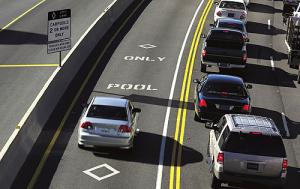Carpooling: Using the HOV lane will be your best career decision yet
Submitted by Amanda Lenkauskas and Charlotte Chamb... on | Updated Thu, 18/01/2018 - 17:13

When you drive alone, it's finally “you time”. It's nice being alone with your thoughts. Playing whatever music you want. Some space and time for you. Just a way to make a gap between the different roles in life. The problem with driving solo is that it's you who has to deal with the stress of it all. Bad driving conditions, bad traffic and bad drivers. What if there was a easier way? Carpooling and using the High Occupancy Vehicle (HOV) lane can change your commute into real “you time”.
When you carpool your commute suddenly has more freedom.
Feeling exhausted after a long day? Take a nap, it's no problem. Want to check who's doing what on Facebook? Go for it. Need to catch up on your favorite TV show before the next season starts, why not?
Sometimes there's an emergency. Emails have to be answered or documents need to be changed last minute.
When you carpool you can be responsive, without pulling off the road and making yourself late.
Flexibility is important.
Sometimes you have to stay back and get the job done. Other times there's something that goes wrong at home and you have to get there fast.
People assume that signing up for carpooling is a twice a day, five times a week obligation but that's no longer the case. With new carpooling apps, you decide when to leave and on any given day you can choose to be a driver or rider.
No need for fixed schedule, routes or routines. You can start instantly by logging in and seeing who is going the same way as you.
So when changes come up, you can adjust carpooling to fit your schedule.
Many cities and states also provide Guaranteed Ride Home programs to make sure you always have a way home in case of emergencies.
This all helps to keep stress down.
In life, we have so many stressful situations. Carpooling is not one of them. It feels good, just sitting there, relaxing.
That makes it the easiest and most comfortable way to negotiate not only traffic but the hectic demands of life.
When you carpool you don't need to decompress after you get out of the car. Without the stress you can just get started with your day, unless you did that already on the way in.
When you put that all together being flexible, responsive and showing up ready to work are a huge bonus.
Carpooling will be your best career decision yet.
But let's be honest, at first it seems like a huge imposition. Should you rely on someone else?
There's also a sense of pride that comes from getting through traffic with your hands at the wheel.
Sure, it’s expensive to drive alone. Pay for parking, regular fill-ups plus wear and tear. But, these costs are an inevitable part of commuting right?
Not really.
By carpooling to work with just one other person you can save $227 per month.
If you carpool just a few days a week you can cut your commuting costs down a lot. All you need is one person, but the larger your carpool is, the more you save.
By the end of the year that's thousands of dollars you could use for your house, family or vacation plans.
When you start carpooling it's like giving yourself a nice little raise.
You'll also be helping to protect the planet. One year of carpooling removes a little bit more CO2 pollution than the trees in an average U.S. city park.i, ii, iii
In this article, we'll discuss the benefits in more detail, as well as give you some suggestions on ridesharing services to check out.
Here's a quick summary of the benefits of switching to carpooling:
|
Money |
Average savings |
|
|
Initial cost |
$0 |
|
|
How long to get back your money |
Immediate |
|
|
Carbon footprint |
Average CO2 savings
|
If you carpooled once a week you would cut your carbon footprint by 402 lbs of CO2 and if you carpooled all year long you would cut 2820 lbs of CO2 ii, vii, viii |
|
Health |
Lower stress |
Feel happier and healthier by significantly reducing the stress level of your commute ix, x, xi, xii |
Life is unpredictable and as much as we would like to, no one can control traffic.
Taking an alternate route when things are stuck will make you feel like you are still moving. But you're probably not going to get there any faster and it might even take a little bit longer.
When you are stuck in traffic maybe you daydream about retirement and not having to deal with this anymore. Maybe you focus on things like: "how long do these lights need to stay red?" or "why are there so many roadworks signs but nobody working?"
Carpooling let's you avoid all of this. You can cruise into the HOV lane and pass by the crazy traffic on your right.
The HOV lane gives you better control over traffic and just a little bit more freedom when it comes to rush hour. Freedom from having to leave early to beat traffic. And more importantly freedom from worrying about how (as well as when) are you going to get there.
Alright that sounds great but what about actually setting one up, is it complicated?
Luckily there are now plenty of apps that take the logistics and hassle out of carpooling.
With a few taps, find others who share a similar commute to yours. People that live, work or go to school in the same area as you and are headed in the same direction.
This way pick up and drop off times are a minimum which makes the carpool experience way less annoying.
Today carpooling can be easily adapted to your schedule. On Monday, you may only need a ride in the morning. Other days, you may need a ride to and from work but need to get somewhere on your lunch break. Between the different platforms, you can mix and match to create a perfectly customized carpooling experience.
There are also some days where driving your own car is a must. If you have to attend an offsite meeting or go to an appointment, changing from rider to driver can be done easily in many carpooling apps, so it's not a problem.
That's flexible but what about safety?
Unless you have a fixed schedule and can commit to some steady partners, you'll have to pick between different people for your carpool needs. Fortunately, the largest apps make avoiding bad apples easy.
They have safety features like verification of the driver’s license, user submitted feedback with a five-star rating system for drivers and riders, as well as the ability to communicate within the software so that no one has to reveal their phone number.
Many can also optionally link with your Facebook account if you prefer to travel with friends, friends of friends or people who have similar interests. All this leads to creating a trusted network of people to share your commute with.
Cutting your commuting costs, how much can carpooling help?
|
Number of passengers |
Average savings per year |
|
1 Passenger |
$2722 |
|
2 Passengers |
$3629 |
|
3 Passengers |
$4083 |
When you think of all the costs of commuting alone, there's things like gas, tolls and parking. There's also the cost of wear and tear on your car, whatever that is.
When you pay for each one of these separately, it doesn't seem like much. But put them all together and the total cost is not so small.
Are you wasting too much of your hard-earned money on commuting?
You don't have too. Sharing the ride with just one person will start putting money back in your wallet in a big way.
And keeping track of all the accounting is super easy these days. One of the great features of carpooling apps is that they calculate how much a rider needs to pay and transfers it to the driver automatically.
Instead of worrying about accounting, all you have worry about is how to spend all the savings.
Choosing to carpool is like giving yourself a raise. Less money spent on your commute means more for the things you love.
A little electronics shopping this weekend? Or maybe a nice trip this winter? Let us know what you choose in the comments below.
Add to that state run carpool incentive programs that earn you monthly cash rewards as well as federal tax breaks and your shopping spree can be even bigger. Carpool incentive programs vary in size depending on your area but the federal commuter benefits program allows you to use pre-tax dollars for your carpool or vanpool, up to $255 per month.xiii
We'll show you how to cash in on these programs in the “How to start” section below.
Switching to carpooling will be your best career decision yet
Carpooling increases your flexibility and availability by making sure you have less to worry about on the way there. Then the fun becomes figuring out what to do with your newly found “you time”.
The average commuter spends almost an hour going from home and back each day.xiv
What would you do with an extra hour each weekday?
Keep on top of your emails? Check up on a loved one? Think about life? Or maybe just do nothing. You decide.
All of which are way more fun than sitting in the left lane wondering why the right lane is moving faster.
Your carpool and the HOV lane will definitely save you often from traffic but another little bonus is the added freedom that you get in the car. The carpool provides you a space to escape.
Not having to divide your attention between driving and something else is a nice change from the regular. Carpooling means you can enjoy the ride without having to focus on traffic.
As a carpool passenger, you are in control of your time whether there is traffic or not. During an average week of carpooling you could:
-
Get 10 power naps. Everyone needs to re-charge those batteries once in a while. Maybe you had a busy weekend or just a long day. A little nap before or after work (maybe both) will keep you energized and more focused for what's next.
-
Read 16 chapters of that book you've been dying to finish.xv, xvi With carpooling, you now have time to unwind with a great book while you're on the way. You'll have enough time to burn through a few great novels every month.
-
Watch 10 episodes of your favorite TV show(s). We've all been there, a new season of your favorite show is about to start and you didn't get a chance to catch up. Carpooling gives you a guilt free way to make sure you are up to date, so next time you won't miss out on the conversation when people are talking about your show.
-
Deal with 240 emails.xvii, xviii In the carpool you can get a head start on the workday. Instead of working late or coming into the office early, you can get stuff done during your commute and then have more time for yourself at home. A few extra hours each week to deal with emails and anything else the boss throws at you will surely get you noticed. It will also help to keep stress down, which is always a plus.
Carpooling lets you do more with your commute.
Whether you use your newly found free time to work or relax, you'll be feeling better either way. Give me a few extra hours each week and I'm sure that I'd be happier too.
Looking for a happier, low-stress commute?
Carpooling can help you. Most people consider their commute to be one of the least fun parts of their day.xix, xx
Why is that? Stress has a huge part to play in how you feel about your commute but what makes it stressful? How about:
-
Aggressive drivers that zigzag and cause near misses.
-
Narrow roads caused by street repairs that make driving tougher than it needs to be.
-
Being stuck in traffic even on days when you left early.
Delays and reliability significantly influence the stress level of your commute. But all of this just boils down to control.
Lack of control is one of the major forces that cause stress while commuting.xxi, xxii
How bad is stress?
Stress has been associated with serious health problems like heart disease, stroke, autoimmune and inflammatory diseases.ix
Higher stress is also directly linked to central nervous system disorders that cause chronic fatigue, depression and insomnia.x, xi
Apart from the harm to your physical health, commute stress often carries over to work and home.xxiii
Is there anyway to make it better?
Control is seen as a mediator of commuting stress.
While improvements in travel time matter for increasing commute satisfaction, it is reductions in travel in congested conditions that matter most, particularly among those susceptible to the stress of traffic.xii
Compared to drivers who experience only infrequent congestion, those who spend more time commuting in congested conditions show drastically different tolerances for travel times.
Carpooling can definitely help here by giving you access to HOV lanes.
When there is traffic everyone has to either go through it or find an alternate route. Many times taking a side street will keep you rolling but not really get you there any faster.
The HOV lane and your carpool will give you better control over traffic.
It's your best bet to by pass traffic jams and get you there on time.
Making good use of your time during your commute is another important way to make the drive in less stressful.
People who put their commute time to good use reported feeling healthier and less stressed.xxi, xxiv
Research also shows that drivers who use their commute time productively are 4.71 times more likely to feel energized at work.xi
Now making good use of your time can mean different things to different people but when you carpool you have more options for how to use that time.
Carpooling gives you way more control over how to deal with traffic and what you can do during your commute. All of this means less stress on the way there.
As well as less stress when arriving at work and back home.
While we all feel and deal with stress as a part of daily life wouldn't it be nice if there was less?
One of the best parts of carpooling is watching as day after day the stress of your commute slowly melts away.
How to start carpooling today?
There's been a change recently and you are looking for the best way to commute. Maybe you recently changed jobs or neighborhoods. Maybe you want to add the convenience and flexibility of carpooling to your commute. Maybe it's just that your car is not as reliable as it used to be.
Whatever your reason, the timing is great. Recent game changing technologies have made carpooling easier and way more flexible.
You could setup a carpool the old fashioned way:
1. Gather your coworkers and neighbors who want to get started.
2. Create a schedule as well as a route for drivers and riders.
3. Decide on the carpool rules and how payment will work.
Or you could use one of the new carpooling apps out there that take the logistics and hassle out of carpooling.
Just enter where you'll be leaving from plus where you're going and the software does the rest. In no time you'll find other carpoolers that are going your way, with the perfect route to pick everyone up calculated automatically. People that live, work or go to school in the same area as you.
Carpools can be planned in advance or in real-time so you can leave whenever you want. Like that you're always in control.
Want to carpool just one way? Or maybe you need to change from driver to rider depending on the day of the week? No problem.
Carpooling with these apps is flexible. And if your schedule changes last minute you can make adjustments with your lift or find a new one.
Accounting is also taken care of automatically. Payments are calculated and transferred directly between users. Usually a maximum rate of 53.5 cents per mile is charged, the current IRS reimbursement rate for business travel by car.v There's no surge pricing or peak rates.
Carpool apps and websites: Which ones are good?
Here are the leading carpool apps and websites. They are all free to sign up and make getting started easy.
Uber is the world's largest ridesharing company. To carpool using their service you'll need to choose, UberPool when selecting a ride. The app will then find others that are going your way to pool with and split the costs. Take a look at availability here.
Lyft is Uber's main competitor. When requesting a ride, you can choose the Lyft Line option to carpool. This let's the Lyft driver to pick up other people along your route - allowing you to split the fare with others. Available in these states and cities.
Scoop's network is not as large as its competitors but it is an app that is focused on carpooling. You can set your AM and PM rides separately up to a week in advanced, as well as schedule different pick-up locations by day too. Currently available in these cities.
Zimride's platform caters to universities and corporations exclusively. You create a profile, say where you want to go and Zimride finds you a match in your school or company. Use their network search to check availability and if not, contact them to bring Zimride to your organization.
Vanpool: The cheapest way to commute
Vanpools are large carpools. With more people to split the costs, the lower your fare will be. But that's not even the best part of vanpooling.
Since there are many people taking the same van, only a few people have to commit themselves to driving. That means most vanpoolers can relax and enjoy a stress free commute.
Vanpool drivers get a different type of freedom. Primary drivers usually ride for free and can use the van for personal trips.
Either way, whether you're a driver or passenger it's hard to beat the savings and freedom of vanpooling.
To get started contact 5-1-1 for information on local vanpool services. You can also check out the main vanpool companies to see what they offer in your area:
-
vRide (Now owned by Enterprise Rideshare)
What does it cost?
With carpooling, everyone shares the costs. What's nice about carpooling apps is that they calculate how much a rider needs to pay and transfers it to the driver automatically.
If you're managing your carpool manually then you can figure out costs by getting into all the details of gas price, fuel usage, insurance, etc. To help break it down, there are some commute cost calculators like MileWiz or Fuelio.
Otherwise you can use this simple method that will give a good approximation for the costs:
-
Take the federal standard reimbursement rate ($.535 per mile in 2017).v
-
Multiply by number of miles driven (Google Maps can help you there).
-
Add to this other costs like tolls or parking.
-
Divide by the number of people in the car.
Chances are that either your state, county or metropolitan area offer some kind of carpool or vanpool incentive program, giving you even more money to cut costs.
The cash incentives can start around $100 and go up to $400 depending on if you carpool or vanpool. Here are some examples:
To see what is available do a Google search for vanpool or carpool incentives plus your area like this: https://www.google.com/search?q=carpool+incentives+washington+dc
Try contacting 5-1-1 as well. They'll have information on any available cash incentives or subsidies for carpools and vanpools.
Another source of cash rewards is your employer. There are many who offer transportation subsidies to help with the costs of your carpool or vanpool as well as preferential, discounted or free parking.
You may also be eligible to receive a tax break if your company offers a deduction for carpools and vanpools. If your company doesn’t pay for these fringes, it might offer a commuter benefits program instead.
Commuter benefit programs allow you to skip paying income taxes on the money you set aside for your commute.
Annually you can use up to $3060 of your pre-tax dollars on carpooling and vanpooling. The savings can add up to a 40% reduction on your commuting expenses.
Check with your Human Resources department or office manager to find out what's available.
HOV lanes
Carpoolers have access to High Occupancy Vehicle (HOV) lanes. These lanes are only for vehicles with a minimum of two or more people (including the driver), which helps move more people in fewer vehicles.
By doing so, HOV lanes offer you a faster, more reliable commute. Especially during times of high congestion.
Carpooling also gives you access to High Occupancy Toll (HOT) and Express lanes free of charge.
If you're using apps like Google Maps or Waze to find HOV lanes make sure toll roads are enabled. In the settings, this is usually called “Avoid tolls” or “Avoid toll roads”.
You'll be able to spot them thanks to overhead signs and diamond symbols on the pavement.
At the entrance of these lanes, a sign always indicates how many people are required in the vehicle to be eligible. It will also show the days and hours if there are specific restrictions.
Zip along in the HOV lane and drive right past congestion. Thanks to your carpool you can say goodbye to rush hour traffic.
What's the best way to get there?
Many carpooling apps take care of route planning for you, but if you are managing a carpool manually you might want some help.
If you forgot how to get to that one part of town or if you just have no sense of direction, your phone can help you get around. From route planning to suggestions on how to avoid traffic, mapping apps are your friend.
Google Maps is a comprehensive option, with plenty of details. It has a simple and easy to understand design that makes it many people’s default for help with directions.
Waze uses real-time updates from it's users about traffic, construction and speed traps to change your route in real-time, getting you there faster. A good option for your daily commute.
Google Maps and Waze are good options but if you are concerned about your privacy or companies profiting from your data there are other alternatives.
OsmAnd as well as MAPS.ME are open source options that use OpenStreetMap which is basically the Wikipedia of online maps.
Carpool karaoke
Music moves people just like a car. That's probably why music and driving have gone together since the first car radio was introduced in the 1930s.
Driving to work is way more fun if you got the right music on. Some people like listening to a neutral radio station but you can also discover and share music with your fellow carpoolers.
In either case, once in a while a song comes on and you just can't help but sing along. When you don't know all the lyrics, use an app like MusixMatch or Genius so that you can sound like a pro.
If you really want to take your carpool karaoke to the next level try apps like StarMaker or Sing! Karaoke.
Local radio stations can be limited sometimes so when you're looking for different options, there are apps that will put huge music libraries, internet radio stations and custom playlists all at your fingertips:
Spotify allows you to browse individual songs, artists, and genres, as well as complete albums. It's great for people who know what they want to hear. Spotify also offers mood-based playlists and suggestions for when you want to discover something new.
Pandora sets itself apart from other music apps because it builds customized playlists based on the music you like. To get started just enter a song, artist’s name or type of music and the app will take care of the rest.
8tracks lets you listen to ad-free music through mixes that each have eight tracks. It's a music service that's all about human-curated custom playlists built around anything from themes to emotions and activities.
Jango Radio offers free unlimited music without any commercial interruptions on their mobile app. You can personalize your stations with the artists that you love or tune in to one of the many stations that have been curated by music experts.
Is taking the carpool lane worth it?
Even if you only carpool once per week, there's a lot to think about to make sure your commute stays easy. There are many concerns that come up before trying out carpooling. Here are some answers to the most frequently asked questions.
What's being done to keep carpooling safe?
You might be worried about who you will be riding with. Thankfully carpooling networks are worried about this as well. Here's a break down on the safety measures each one has in place:
|
|
Zimride xxxvi |
|||
|
Driver background check |
Yes |
Yes |
Yes |
No |
|
Rate your rider/driver |
Yes |
Yes |
Yes |
Yes |
|
Anonymized phone number/Internal messaging |
Yes |
Yes |
Yes |
Yes |
|
Connect via Facebook |
No |
Yes |
No |
Yes |
|
Connect via university/corporate network |
No |
No |
Yes |
Yes |
It's nice if you know a little about who you are sharing a ride with. Driver background check and rating systems help a lot with this. The rating systems are all designed to match you with the best possible drivers, keep bad eggs out of the system, and incentivize everyone to be respectful. Like that you'll know about riders who have a habit of eating tuna sandwiches on the way home and drivers who enjoy street racing.
Anonymizing phone numbers and internal messaging help keep everyone connected while keeping contact details confidential. So when you and your driver need to contact each other, your personal information stays private.
Some carpooling networks can optionally link with your Facebook account. A few also connect people who work or go to school at the same place. This just makes it easier to find carpool buddies that you'll get along with by helping you find people who are connected to you in some way, either by common destination, interests or people you both know.
Carpooling is just not flexible enough for me...
In the past, carpooling meant you needed a fixed group of people who commit to meeting at a fixed time and place every day. But a fixed carpooling arrangement doesn’t meet today’s demands of flexible working hours and unpredictable schedules.
What if your boss asks you to work late at the last minute? What if you feel ill at work or there is a family emergency?
Carpooling gives you access to your local Guaranteed Ride Home Program. This program provides an emergency ride home to help carpoolers deal with the unexpected.
So when there are last minute changes or emergencies just take a taxi, bus or rental car home and get reimbursed. Like that you don’t have to worry about being stranded.
When you carpool, the Guaranteed Ride Home Program is insurance for your commute.
As always you can try 5-1-1 to see what is available locally or do a Google search for Guaranteed Ride Home or Emergency Ride Home plus your area like this: https://www.google.com/search?q=guaranteed+ride+home+los+angeles
Check with your Human Resources department also, they can let you know if your employer provides it's own Guaranteed Ride Home program.
Won't carpooling add time to my commute?
Usually it's the opposite. Carpooling gives you access to the HOV lane which will get you through traffic faster. Carpooling apps also find you the best route to pick up passengers and help you avoid traffic along the way. Together these two more than make up for the few minutes it might take to pick up one or two passengers. The farther your commute, the more time you’ll tend to save.
Will carpooling affect my car insurance?
Since carpool drivers don't make a profit on their trips there is no risk of voiding your insurance. Carpooling apps make all the calculations and payments easier but legally it's treated the same way as regular carpooling with no app. Drivers get reimbursed for a portion of the cost of their commute, which the IRS does not consider income as long as it comes in under the stated limit which is $0.535 per mile in 2017. You can see the IRS guidelines on standard mileage rates here.
What about my personal space?
When you drive alone, there is time and space for you. But when you carpool that alone time disappears. A carpool, previously would often be made between people who know each other like family members, neighbors and/or co-workers.
Knowing the people in your carpool creates a different dynamic in the car. You'll feel more obligated to engage or at least listen to conversations as a captive audience.
Luckily with new carpooling apps you can pick and chose who you carpool with. Like that you can avoid learning more about your neighbor's passion for stamp collecting.
This allows you to keep your personal space in your commute.
You don't have to be anti-social if you don't want to be. But with carpooling apps you can now reap the benefits of the HOV lane and squeeze in an episode of your favorite TV show without feeling bad about not chatting endlessly with your fellow carpoolers.
Using the HOV lane will be your best career decision yet
You might be skeptical at first. Driving alone means freedom and no one wants to lose that.
But instead of losing freedom, you end up getting a lot more than before.
More time for yourself. Carpooling gives you the option to do things like catch up on emails or catch up on some sleep.
More freedom from traffic. Carpooling gives you access to the HOV lane. It's your best bet to by pass traffic jams.
Carpooling gives you more control over your commute.
Getting you from home to work and back again without the headaches. Once you give it a try you'll see that it's nice not having to concentrate on driving.
These days carpooling has the convenience that comes with driving. The only difference is much lower costs and stress.
Not only does it save you money, but also wear and tear on you.
Carpools can offer you a real alternative to driving alone. Less stress with more of your paycheck left in your pocket at the end of the month. What would you do with the extra money each month?
Costs aside, there is a lot of convenience and flexibility to be gained by carpooling.
Getting started has never been easier. Smartphone apps help plan your commute, creating readily available and convenient carpools that can be joined on the fly.
Carpooling networks are helping people to cut commute costs by thousands of dollars each year, reduce their carbon footprint, and win back hours of the day.
All while keeping stress down, making the commute way more comfortable.
Carpooling lets you do more with your commute. Whatever you choose to do will either directly or indirectly end up helping your career.
Whether you use your newly found free time to work or relax, you'll be feeling better either way.
If you're tired of sitting in traffic, paying for gas and dealing with parking every day, there is an easier way.
We all feel and deal with stress as part of daily life. Carpooling is a way to skip some of that stress and turn the drive into real “you time”. It's the most hassle free way to commute.
i U.S. Environmental Protection Agency. Inventory of U.S. Greenhouse Gas Emissions and Sinks: 1990-2015. Washington, DC: 2017.
ii Harnik, P., McCabe, C., Hiple, A. 2017 City Park Facts. The Trust for Public Land. San Francisco, CA: 2017.
iii Nowak, D., Heisler, G. Air Quality Effects of Urban Trees and Parks. National Recreation and Park Association. Ashburn, VA: 2010.
iv Oak Ridge National Laboratory. Summary of Travel Trends: 2009 National Household Travel Survey. U.S. Department of Transportation. Washington, DC:2011
v U.S. Internal Revenue Service. 2017 Standard Mileage Rates, Notice 2016-79. Washington, DC: 2016.
vi American Public Transportation Association. June Transit Savings Report 2017. Washington, DC: 2017.
vii Intergovernmental Panel on Climate Change. 2006 IPCC Guidelines for National Greenhouse Gas Inventories. Geneva, Switzerland: 2006.
viii Bureau of Transportation Statistics. National Transportation Statistics, Table 4-23. U.S. Department of Transportation. Washington, DC: 2017.
ix Holland, D. Cost of Commuting: A Review of Determinants, Outcomes, and Theories of Commuting-Related Stress. University Honors Theses. Paper 299. 2016.
x Robbins, W., Berman, B., Stone, D. Health Effects of Vanpooling to Work. Workplace Health & Safety. 63, 12, 554-563, 2015.
xi Loong, C., van Lierop, D., El-Geneidy, A. On Time and Ready to Go: An Analysis of Commuters’ Punctuality and Energy Levels at Work or School. Transportation Research Part F: Traffic Psychology and Behavior. 45, 1-13, 2017.
xii Higgins, C. D., Sweet, M. N., & Kanaroglou, P. S. All minutes are not equal: travel time and the effects of congestion on commute satisfaction in Canadian cities. Transportation, 1–20, 2017.
xiii U.S. Internal Revenue Service. Employer's Tax Guide to Fringe Benefits 2017. Washington, DC: 2016.
xiv U.S. Census Bureau. American Community Survey. 2016 American Community Survey 1-Year Estimates, Table S0801. Washington, DC: 2016.
xv Frazier, C. 65 Bestselling Word Counts. Better Novel Project: 2014.
xvi Trauzettel-Klosinski S, Dietz K. Standardized assessment of reading performance: the New International Reading Speed Texts IReST. Invest Ophthalmol Vis Sci 2012;53:5452–61.
xvii Chui, M., Manyika, J., Bughin, J., Dobbs, R., Roxburgh, C., Sarrazin, H., Sands, G. & Westergren, M. The Social Economy: Unlocking Value and Productivity through Social Technologies. McKinsey Global Institute: 2012.
xviii Levenstein, J., Radicati, S. Email Statistics Report, 2015-2019. The Radicati Group: 2015.
xix Kahneman, D., A.B. Krueger, D. Schkade, N. Schwartz and A. Stone. Toward National Well-Being Accounts. The American Economic Review 94, 429–434, 2004.
xx Wheatley, D., Bickerton, C. Time-use and well-being impacts of travel-to-work and travel-for-work. New Technology, Work and Employment 31, 3, 238–254, November 2016.
xxi Gottholmseder G, Nowotny K, Pruckner GJ, Theurl E. Stress perception and commuting. Health Econ. 2009, 18: 559-576. 10.1002/hec.1389.
xxii Legrain, A., N. Eluru, and A. El‐Geneidy. Am stressed, must travel: The relationship between mode choice and commuting stress. Transportation Research Part F: Traffic Psychology and Behaviour, Vol. 34, 2015, pp. 141‐151.
xxiii Smith, O. Commute well-being differences by mode: evidence from Portland, Oregon, USA. J. Transp. Health. Vol 4, 246-254, 2017.
xxiv Sandow, E., Westerlund, O., Lindgren, U. Is your commute killing you? On the mortality risks of long-distance commuting. Environ. Plan. A 46(6), 1496–1516, 2014.
You will save the Earth by sharing and/or tweeting (corny right?)





